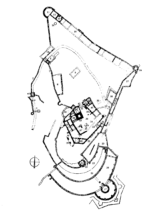Trencsén
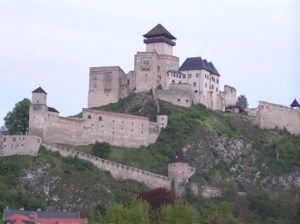
The castle of Trencsén (Trenčín, Trentschin) is in Slovakia, it was an important fortification of the Kingdom of Hungary in the Vág Valley, near the old Polish border. The first Hungarians took it from the hands of the Polish knight, Bolislo the Brave, in 1017 along with the rest of Trencsén County. The great Hungarian chronicle writer, Anonymous, Notary of King Béla, thought Trencsén was worth mentioning in his work in the late 12th century.

Thanks to its stone walls the fort was one of the few lucky castles that withstood the Mongolian siege in 1241. It is no wonder that it was kept in high esteem in the future. It served as a frontier stronghold that guarded over the valley of the Vág River.

When royal power was declining, the castle became the headquarters of the Hungarian Baron Csák Máté whose power was broken only when he died in 1321. Despite his death, King Károly Róbert was only able to take the fort after a long siege. Károly Róbert strengthened his ruling power by breaking down the authority and control of the feudal lords all over the country. He took care to appoint the Chief Comes of Temes County as his castellan of Trencsén Castle. (Please, note that I use the Oriental name order for Hungarian names where family names come first.)

After this time, the fort was always given to the actual Chief Comes of Temes County which proves the importance of the position. Trencsén lay in a strategic location and it was considered accordingly. King Károly Róbert recognized this and it was at Trencsén where he received the monarchs of Poland and the Czech Kingdom in 1335. This Anjou king prepared the country for the next strong-handed Hungarian king, Lajos (Louis) I the Great.

King Lajos did not neglect Trencsén Castle. Having rebuilt it, he gave it to his daughter, Maria. King Lajos received Zsigmond (Sigismund) of Luxembourg in Trencsén castle and they agreed there that Zsigmond would marry Maria. Consequently, King Lajos’ candidate for the throne of Hungary was the young Zsigmond.

When Zsigmond became king of Hungary, he had Trencsén reinforced against the cannons of the heretic Hussites, and shortly after he gave it to his queen, Borbála. Had King Sigismund known what troubles the Bohemian Hussites would stir in his realm he would not have permitted the burning at the stake of Jan Hus in 1415.
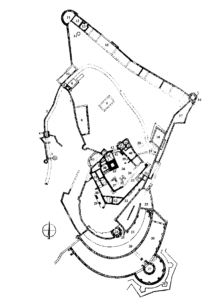
But it was too late: the followers of the church reformer were gaining more and more ground. It did not take them much time to reach the walls of Trencsén. They did not hesitate to besiege it in 1431, but they were repulsed by the defenders. The Czech mercenaries were furious at this and quit the siege. On their way home, they set the town on fire burning it down to the ground.

However, they never gave up and were waiting for their chance. Their desire was fulfilled in 1440 when Trencsén came into the possession of the Hussite leader, Jan Giskra. He had originally been hired by Queen Erzsébet to aid in her attempts to seize the throne, but the Hussites took themselves into Upper Hungary and soon became their own masters. The famous Hunyadi János led many campaigns against them and eventually, he managed to get Trencsén back in 1450. Yet, the Hussites were persistent and were in control of large areas. The folks of the Upper Lands suffered a lot because of them.

Giskra finally agreed with János Hunyadi’s son, the young King Matthias of Hungary. According to their treaty, the remaining Hussite-owned castles were returned to the king in 1462. It was a very good decision for the king because Giskra became his most faithful mercenary captain. These Czech mercenaries were the core of the first standing army of Europe, the king`s Black Army.
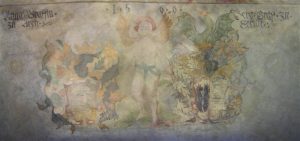
King Matthias started staying in Trencsén for longer periods and it was his headquarters when he led his campaigns against the Czech and Moravian lands. Some years later in 1475, he sold Trencsén to Baron Szapolyai for 15,000 gold coins in exchange for his faithful services. This sum was considered a very low price and was rather a token payment. The castle remained the king`s property and he could buy it back at any time. You can read more about the Black Army of King Matthias Corvinus here:
https://www.hungarianottomanwars.com/essays/the-size-of-king-matthias-army/

A heart-breaking legend about the well of the castle dates back to those years. (You can read it in my book “33 Castles, Battles, Legends”). When Matthias, the last great king of the Hungarians died in 1490, the Szapolyai family left Szepes Castle and moved to Trencsén Castle to live. They enlarged the fort and people began to call them “Trencséni” aka Szapolyai of Trencsén. Their fame and power grew every day. There was no question that their loyalty was much needed by the weak-handed King Ulászló II, who quickly reinforced them in their ownership in 1499. It was during this time that the outer walls of the town were built.

The most perilous of times were approaching the country. The Ottomans defeated the Hungarian army at Mohács in 1526. This was why Trencsén Castle and its town became more significant, because its owner, Szapolyai János, became the king of Hungary during the same year. The Dual Kingship began when Habsburg Ferdinand announced his claims to the throne and was crowned as another Hungarian king. His formidable mercenary army, the one which had sacked Rome in 1527, was steadily pushing Szapolyai out of the country.

King János was able to keep his castle until the usurper`s commander, General Katzianer, besieged it in 1528. The siege lasted for a month and the defenders fought valiantly, but a cannonball set a roof on fire and the flames spread over the whole castle. The inferno blew up gunpowder in many places in it and the warriors in the fort suffered great losses. The artillerymen of General Katzianer had a deadly aim and it was impossible to extinguish the fire. There was nothing else to do, the castle had to be surrendered.
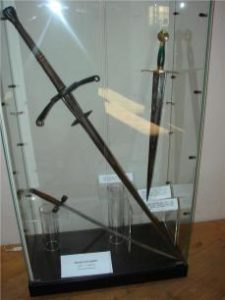
King Szapolyai János fled to Poland and stayed there for a while. He later resumed his fight against King Ferdinand. The wars of the Dual Kingship served no one better than Sultan Suleiman who was quietly biting off chunks from the lands of the two rival kings.

Eventually, the new lord of Trencsén was Ferdinand who sold it to Thurzó Elek for 40,000 gold Forints in 1534 but it returned to the Court in 1548. The damages from the previous siege were being very slowly rebuilt. Later in 1586, the castle went to the Illésházy family under the condition that they would rebuild it. They kept their word and made major constructions on it with the help of Italian masters.

When the fort was nicely rebuilt, the Habsburgs became so fond of it that they wanted to have it at any cost. Cunningly, they accused Illésházy István of treason and deprived him of his domains. This was a general method employed by the Court and Illésházy was not the only one whose property was taken in this manner. Soon, all the deprived nobles were alienated from the king and they began to support the rebellion of Bocskai István. Prince Bocskai and his savage Hajdu soldiers finally forced the king to give Trencsén back to Illésházy István.

It was at this time that the Transylvanian princes led their wars against the Habsburgs. Illésházy’s heir, Gáspár, joined the Transylvanian Prince Bethlen Gábor and fought alongside him against Vienna. After these wars, Illésházy Gáspár was able to enjoy some peace in Trencsén Castle from 1627 until his death in 1648.

Let us not forget the Turks who were not idle either. They attacked Trencsén and set the settlement on fire in 1663 but they did not dare to attack the high walls of the castle. Unlike the Ottomans, the German troops were more successful and were able to occupy the proud fort in 1670. Thirty-three years later the German garrison fled in advance of the soldiers of Prince Rákóczi Ferenc II. The castle burned down in 1790 and has been under renovation from 1954 to the present.

Dear Readers, I can only make this content available through small donations or by selling my books or T-shirts:
Please, feel free to support me with a coffee here:
You can check out my books on Amazon or Draft2Digital, they are available in hardcover, paperback, or ebook:
https://www.amazon.com/dp/198020490X or at https://books2read.com/b/boYd81

My work can also be followed and supported on Patreon: Become a Patron!http://Become a Patron!
[wpedon id=”9140″]

https://hungarianottomanwars.myspreadshop.com/all









